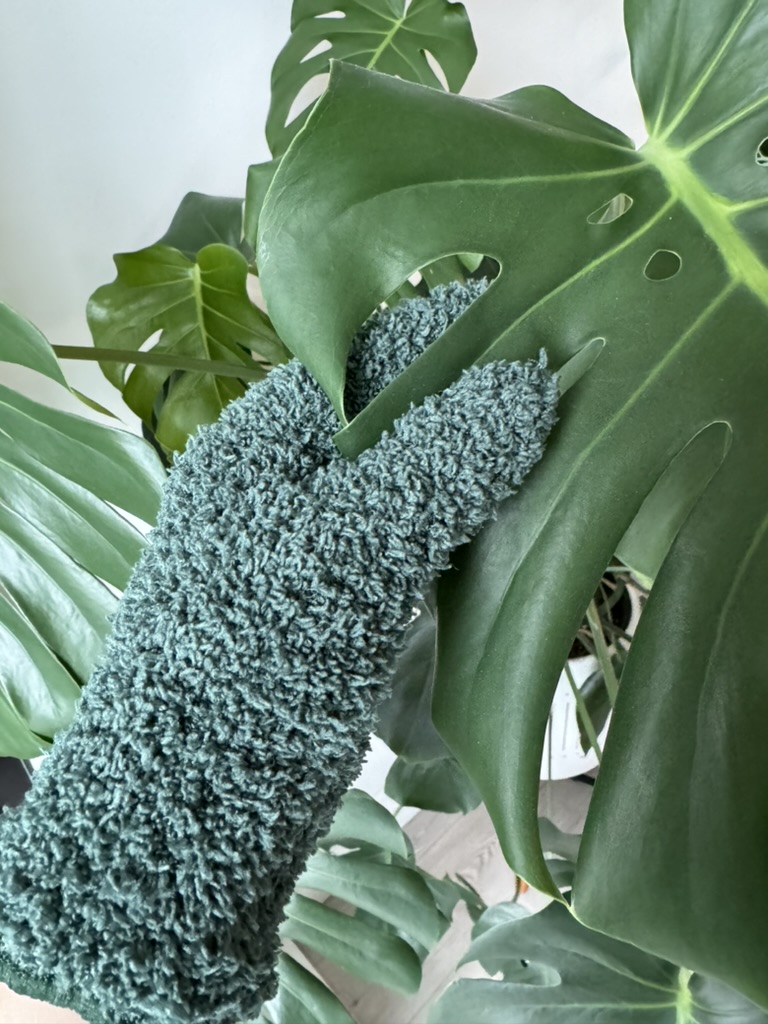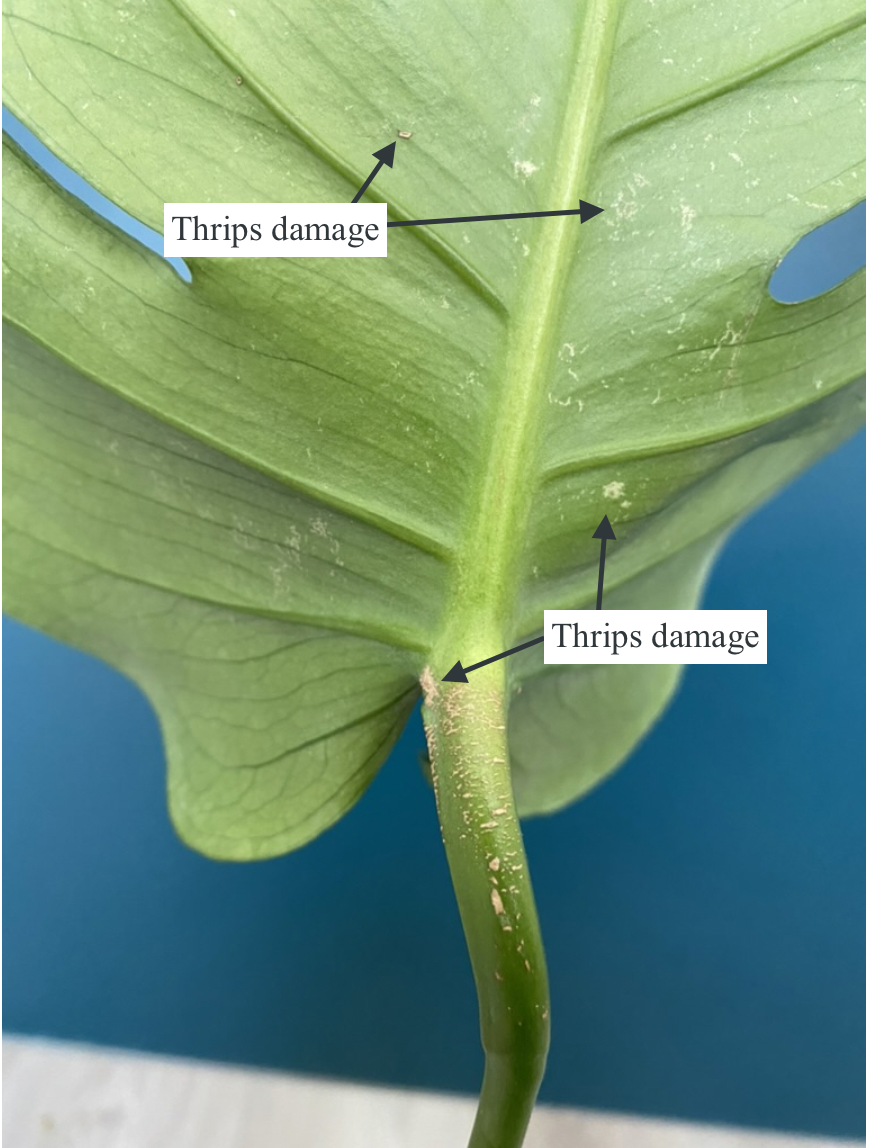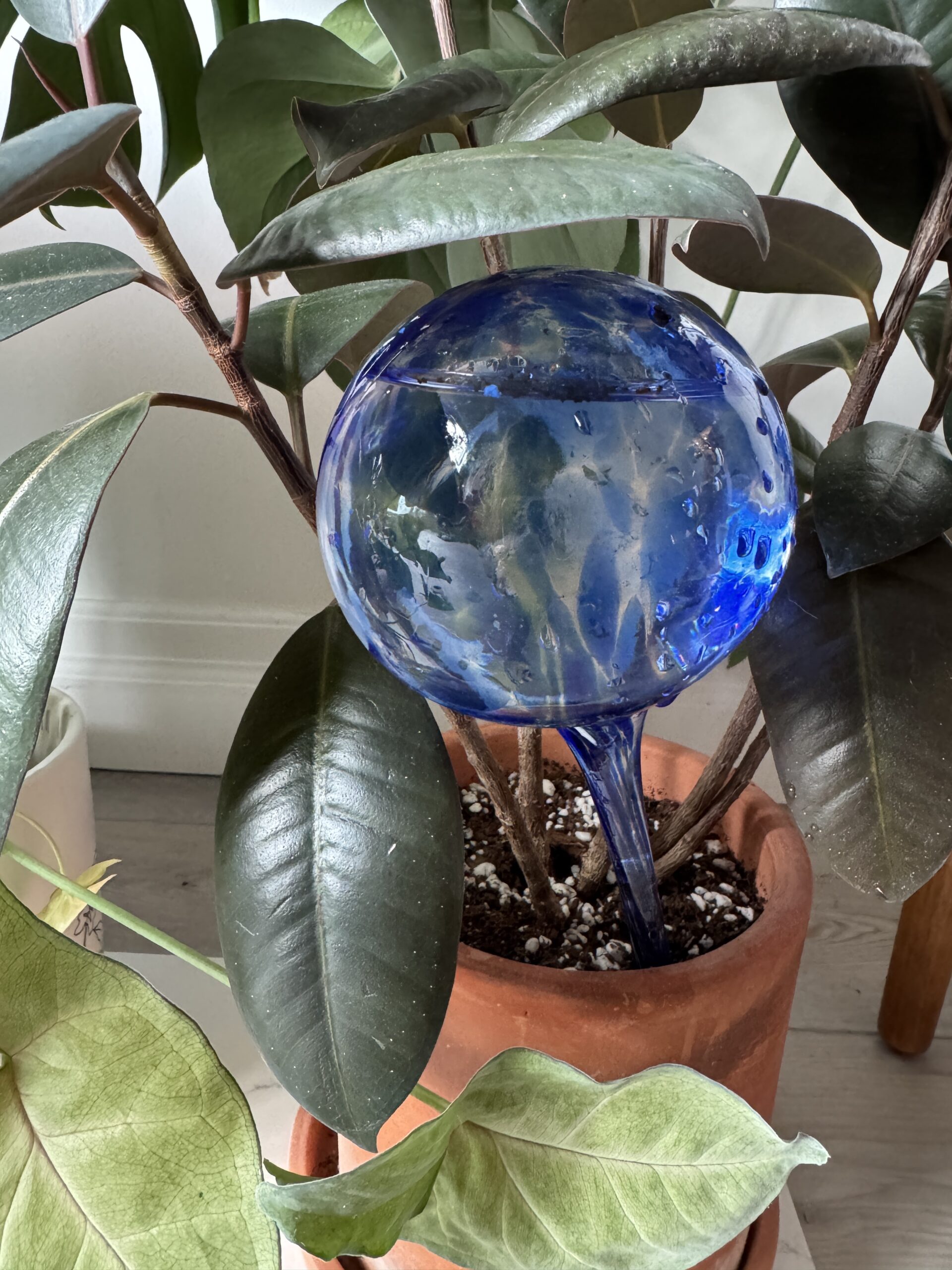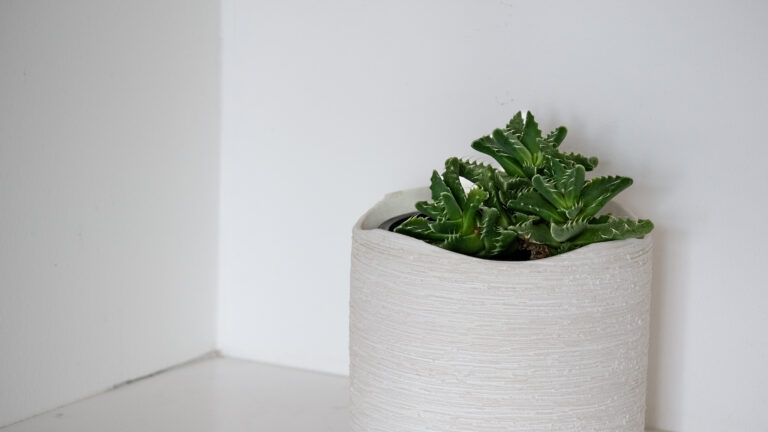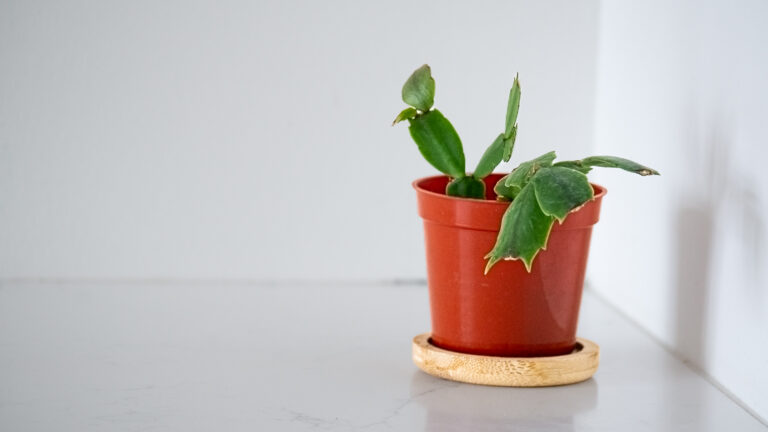Calathea Marion or Goeppertia Roseopicta ‘Marion’ is a member of the Goeppertia family. This plant is a cultivar and considered part of the “prayer plant family.”
It was recently discovered that 200 species of Calathea were actually part of the Goeppertia family. This is one of these instances, and why the Goeppertia Rosepicta ‘Marion’ is known as Calathea Marion commonly.
There are currently 243 accepted species of Goeppertia.
Calathea Marion Appearance & Growth Habit
Calathea Marion has roundish leaves (kind of scalloped). The top of the leaf looks kind of painted (similar to the Medallion) with silver on green and the back side of the leaf is a nice purple.
During the day the leaves of the plant are facing down and you can see the top part of the leaf. At night the leaves open up towards the sky and you see the underside of the leaf. This is why the plant is considered a prayer plant.

Light Requirements for Calathea Marion Indoors
Calathea Marion thrives in medium-bright light. They prefer less sun during the day (early or late sun) and east or north facing windows.
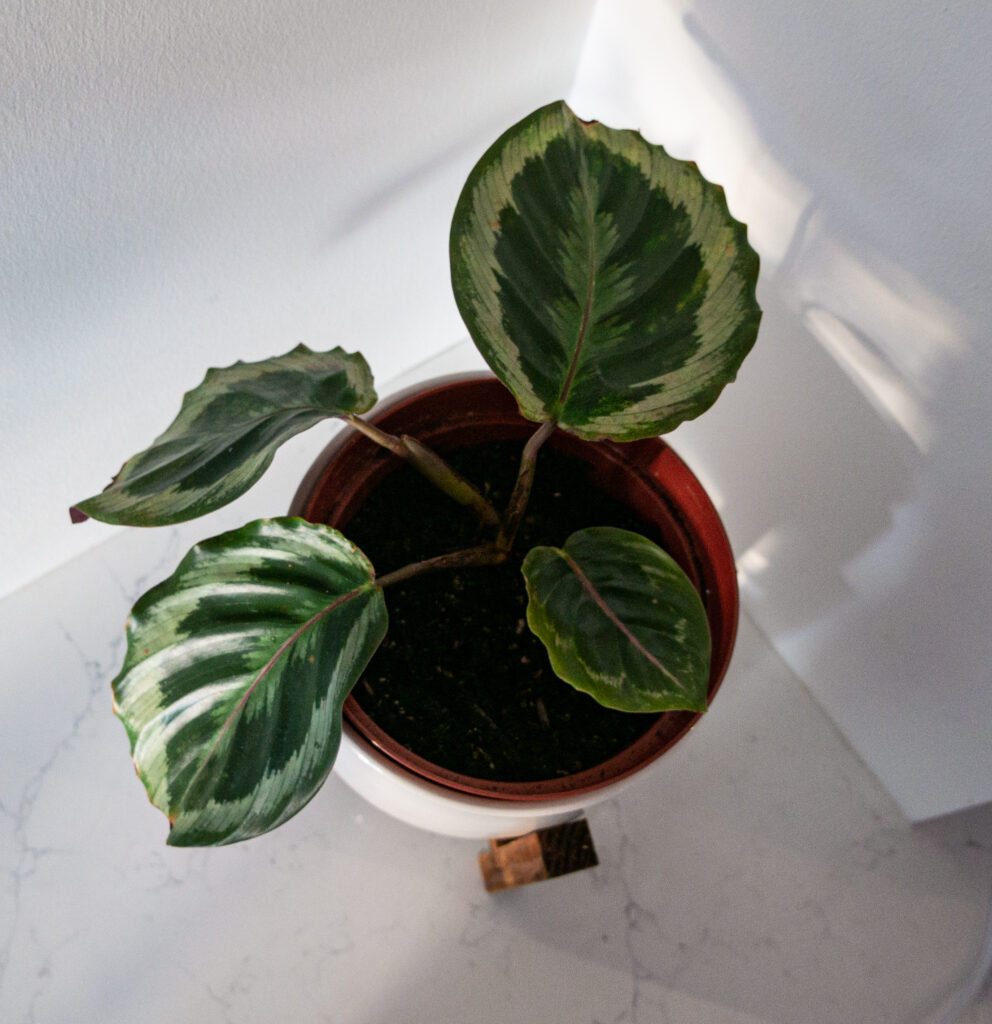
Ideal Temperature & Humidity for Calathea Marion
Calathea Marion prefers a temperature between 18-27 degrees celsius, but can tolerate 15 degrees celsius at. They also prefer higher humidity. Since the genus comes from tropical regions, they prefer moist air and high humidity levels (50-80%). Keep it close to your humidifier.
I would keep Calathea Marion closer to the humidifier (I use the Levoit Hybrid Ultrasonic Humidifier (LV600HH)).
I use my humidifier to ensure the humidity levels in my apartment stays between 40% and 60% (ideally above 50&, but I live in Canada and the winters can be very dry, and the humidity can drop below 30%), so its helpful to set the humidity at 50%.
Growth Rate & Fertilizer Needs for Calathea Marion
On average, Calathea Marion can grow up to 2-3 feet.
Calathea Marion grows in sort of an upright, clump forming way. The leaf grows from the centre and is tightly furled. As they grow taller, they also grow out.
To encourage healthy, lush foliage fertilize your Calathea Marion with a balanced fertilizer every 4–6 weeks during its growing season (spring and summer).
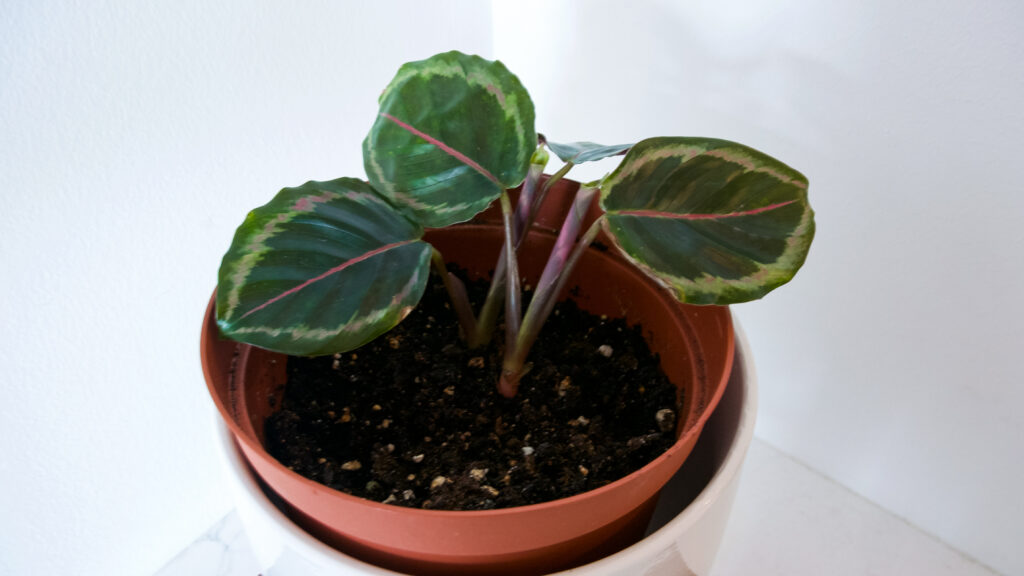
When & How to Repot Calathea Marion Indoors
When to Repot:
You will know its time to repot your Calathea Marion if it has been 2 years, or when you notice roots growing out of or circling the bottom of the pot, slowed growth, or soil that no longer drains well.
The best time to repot is in spring (just before the Calathea’s active growing season).
How to Repot:
Choose a pot one size larger (2″ bigger) with a drainage hole. Cover the bottom with fresh, well-draining potting mix. Grab the Calathea from its current pot, and gently detangle the roots. Be very careful as Calathea are prone to transplant shock. You will want to have enough soil in the new pot that the base of the Calathea is 1″ from the top of the pot.
Add any additional soil as required, and place the Calathea in the center of the pot. Add any additional soil that is needed to cover the roots. Gently pat down the soil around the Calathea so it is stable. Water the Calathea, and place it back in its usual bright, indirect light.
For everything you need to successfully repot your Calathea, check-out my guide on repotting essentials.
Calathea Marion Blooming: What to Expect Indoors
Calathea Marion does not often flower indoors, but when it does they are small, inconspicuous white or purple flowers close to the base of the plant.
Most people get a Calathea for its striking, and moving foliage as opposed to its blooms.
How to Propagate Calathea Marion (Division & More)
The easiest way to start a new Calathea Marion is by Division.
Offshoots/Division: Look around the base of the plant for offshoots. Make sure the offshoots are at least 2 to 3 inches tall before separating them from the mother plant. Gently remove them from the parent plant by separating them at the base, and plant the offshoot into a new pot. Make sure you water the newly divided plant and place them in a bright location with indirect light.
Patience is key with propagation. Give your new plant time to settle into its environment. Once you see new growth, you know your plant is well established.
Watering Calathea Marion: How & When
It’s important to use rainwater or distilled water when watering the Calathea Marion. Filtered and tap water burned the foliage on my Calathea Marion. This stopped after I switched to rainwater.
The Calathea Marion likes to be watered when half dry. To determine if your plant needs water, you can stick your finger in the soil (1 to 2 inches) and if it is dry, its ready for water!
If you don’t want to get your hands dirty, you can try a moisture meter (I personally have not used one, but I know quite a few people who do, and this one is really highly rated on Amazon).
This plant typically needs to be watered every week (depending on your environment).
I typically bottom water this plant through the drainage hole of the pot on a tray. It’s the easiest way to know if your plant is thirsty or not. Overwatering can lead to fungus gnats, root rot, or the death of your plant.
You can top water, but it’s best to do so in a pot with drainage until water is flowing out of the hole. If your pot doesn’t have drainage, you might accidentally drown your plant or make some fungus gnats very happy.
You should top water from time to time to make sure any built up minerals can wash through the plant. The water should drip out of the bottom of your drainage hole.
If you are going away, and worried about watering your Calathea, check-out my guide on 3 ways to keep your plant alive while on vacation.
Common Pests & Problems in Calathea Marion
Calathea Marion can face the following pests and problems.
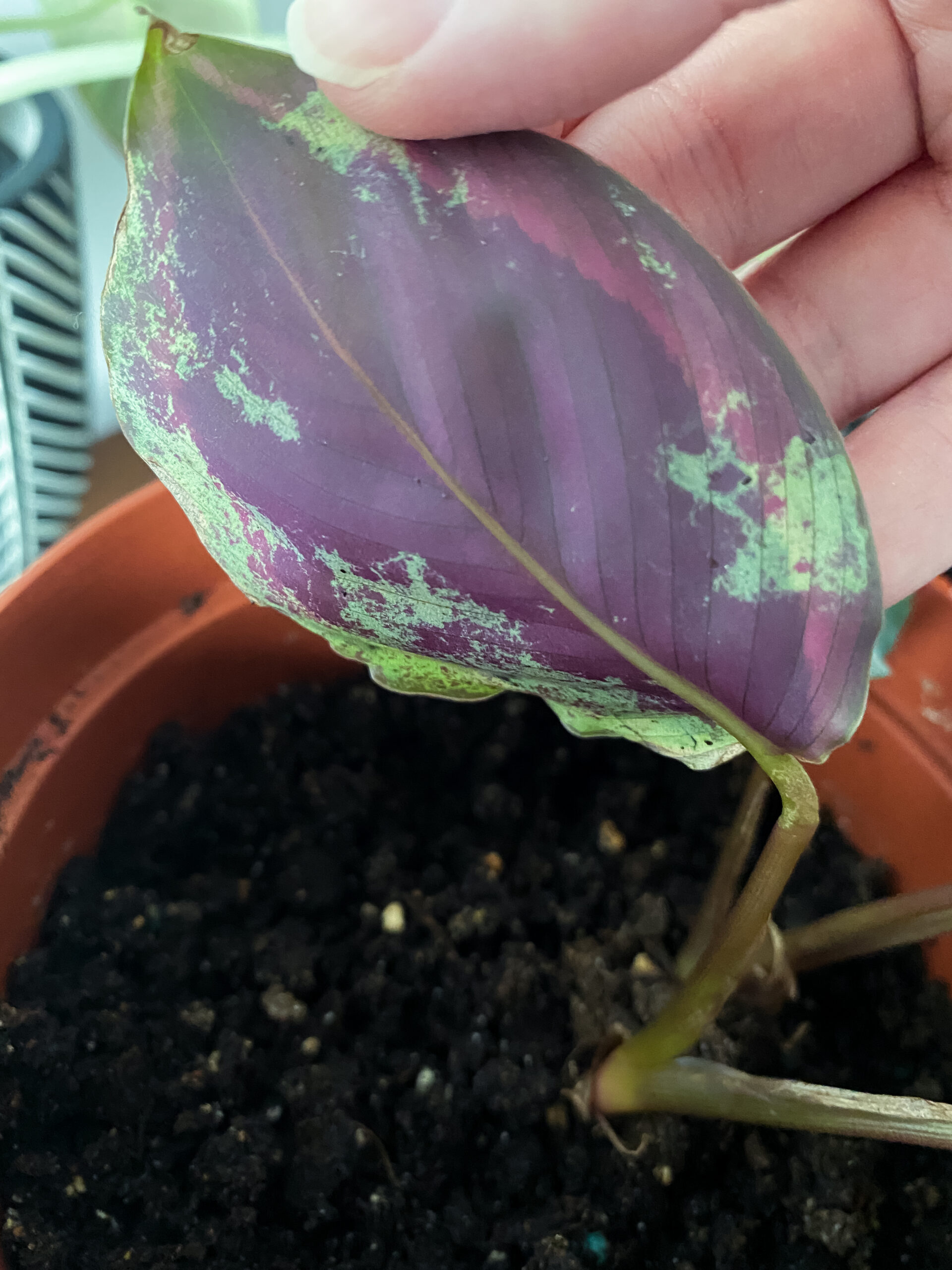
Pests of Calathea Marion
Fungus gnats
Spray the plant with a mixture of neem oil, dish soap and water. I also let the soil dry out and add dryer sheets on top of the soil so the gnats can’t sense the moisture on the soil.
Spider Mites
If spider mites have taken to your plant, spray them with a mixture of neem oil, dish soap and water (or you can buy an insecticidal soap). I repeat this about once or twice a week (depending on the severity of infestation) for about a month. It’s also good to do this preventatively once a month or so. You will know you have spider mites if you see webbing and leaf damage. Learn how to eradicate Spider Mites.
Thrips
Thrips are little, dark bugs that look like dirt. They suck the life out of the leaves, and lay eggs within the tissue of the leaf. As they age, they can grow wings and infect other plants. I spray the plant with a mixture of neem oil, dish soap and water. I repeat this every few days to try and get both the pest and the eggs. Sometimes I just chop the affected leaf since they are hard to eradicate. Complete guide on how to get rid of thrips.
Mealy Bugs
Mealy bugs look like little white cotton balls on the plant. You can remove these with your fingers if you catch them early enough, but I would use a cotton swab with a drop of Isopropyl alcohol and try to scrape them off the stem.
Scale
I’ve never personally had scale (knock on wood) and I am very thankful. Scale are small, brownish, round or oval insects that attach themselves to the leaves or stems of the plant. They are hard to notice as they appear like a growth or bump on the plant. Scale can cause yellowing, wilting, and weakened growth. Removing scale from a plant is tedious, like with mealybugs. You can remove scale by manually removing them with a cotton swab with rubbing alcohol, using insecticidal soap or horticultural oil.
Aphids
Aphids are small, insects that cluster under leaves and stems. They can appear white, brown, black, gray, light green or yellow. If you see distortion, wilting or yellowing leaves, this can be a sign of aphids. You should be able to spray them off with a strong stream of water or using insecticidal soap.
Other Common Problems of Calathea Marion
- Leaf Burning and/or Leaf Curling: This is likely caused by leaf burn and lack of humidity. Leaf burn happens with tap water with high levels of fluoride or chlorine is used for watering. It’s best to use rainwater or distilled water for Calathea Marion. Leaf burn can also happen if the sun is too intense.
- Fading Leaf Colour: This can also happen if the sunlight is too intense.
- Transplant Shock: Calathea Marion does not like to be repotted. This can lead to drooping leaves, and may look like your plant is about to die. Just be patient, and your plant will bounce back.
- Drooping Leaves: Your plant is likely thirsty. Just give it a little water and it should be as good as new.
- Yellowing Leaves: If you have a new leaf coming in, your plant is likely fine. Plants pull energy from older leaves to support new growth. But it can also indicate over- or under- watering or lighting issues.
- Overwatering: Root rot happens from overwatering your plant with insufficient drainage. You can improve the drainage of your plant by ensuring your plant is potted in a planter with a drainage hole and using a well draining soil (something with a decent amount of perlite). You can also end up with fungus gnats or fungal disease from overwatering.
- Underwatering: Signs of underwatering include leaves becoming shrivelled, discoloured or dry.
- Cold temperatures: Damage from cold temperatures can lead to vulnerability to disease, visible discolouration, growth stagnation or death. You can prevent this by making sure your plant is not exposed to environments below the recommended temperatures.
Calathea Marion Toxicity
Calathea Marion are typically not toxic to touch or consume for pets or humans, however some people may experience allergic reactions.
Generally, this plant is safe for curious pets or children so you don’t need to worry about accidental ingestion or contact.
Calathea Marion Quick Care Guide
| Scientific Name | Goeppertia Roseopicta Marion |
| Nickname | Calathea Marion or Prayer Plant |
| Origins | Cultivar |
| Light | Bright, medium-light (no direct sun) |
| Temperature | 18-27 degrees celsius (preferred)te during the winter |
| Humidity | High (50-80%) |
| Height | Up to 3 feet |
| Blooms | Not often indoors |
| Propagate | Division |
| Water Frequency | When half-dry (likely once a week) |
| Pests | Fungus Gnats, Mealy Bugs, Aphids, Scale, Spider Mites, Thrips |
| Common Problems | Leaf Burn, Transplant Shock, Curling Leaves, Brown Edges, Faded Leaves,Overwatering (root rot), underwatering, cold temperatures |
| Toxicity | Non-toxic |
References
Below is a list of external sources I consulted while writing this post. This post is a mixture of my own experiences, and the external sources listed below:
https://myplantin.com/plant/148297
https://en.wikipedia.org/wiki/Calathea
https://jomostudio.com/products/calathea-marion
https://en.wikipedia.org/wiki/Goeppertia

